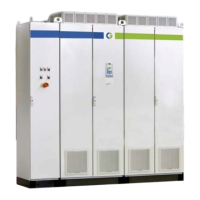44 FDUL/VFXR/FDUG/VFXG/AFR/AFG Main features CG Drives & Automation, 01-7318-01r1
7.17.3 Grid fault ride through and
Anti Islanding
Grid voltage and frequency disturbance handling such as
grid fault ride-through (FRT) and anti-islanding detection
(AID) are standard requirements for fulfilling the grid codes
for distributed renewable generation systems (DRGS)
connected to either the low-voltage (200-690 V) or medium
voltage networks (1-25 kV), i.e. IEEE 1547, IEC 50438/
50549, BDEW etc. This section gives a detailed description
of the FRT and AID functionality implemented in the
CG/Emotron Active Front-End for Generation (AFG)
intended for renewable energy sources (RES). The FRT and
AID features are implemented in AFE software (SW) option
version 97.10 and later, and requires the SVMB version 2,
see section for grid voltage measurement.
The AFG continuous and transient operation capabilities
are listed in Table 12 and should be considered as the
absolute maximum operation capability.
7.17.3.1 Grid fault ride through (FRT)
This section specifies the transient operation capability of the AFG during FRT, i.e. during grid disturbances. The absolute FRT
capability of AFG is developed in order to include as many grid codes as feasible but priority has been given to fulfill the
requirements for Europe (EN 50549-1 and EN 50549-2) and US (UL 1741- Supplement SA).
Grid fault ride through (FRT) capability of AFG includes following main functions.
- Over voltage ride through (OVRT)
- Under voltage ride through (UVRT)
- Over frequency ride through (OFRT)
- Under frequency ride through (UFRT)
For grid fault ride through (FRT) (both voltage and frequency) the AFG can (by own control means) handle grid disturbances
that limits the actual AC output generated power by dissipating the possible excessive energy (feed into the AFG) into a brake
resistor via the integrated brake chopper IGBT.
Table 12
Electrical Quantity Continuous operating range Comment
Voltage (U) 85 - 110% of U
N
340 - 440 V @ UN = 400 V
Current (I) 0 - 110% of I
N
Active power (P) 0 - 100% of S
N
(limited by I
N
)
100% @ cos
Φ = 1.0
90% @ cos
Φ = ±0.9
Reactive power (Q)
±100% of S
N
(limited by I
N
)
Q > 0% (over-excited)
Q < 0% (under-excited)
±100% @ P = 0%
±48% @ P = 90% (cos? = ±0.9)
±0% @ P = 100% (cos? = 1.0)
Power factor (cos
Φ)
±0.01 - ±1.0
cosΦ > 0 (over-excited)
cos
Φ < 0 (under-excited)
Frequency (F)
85 - 115% of F
N
(absolute maximum)
42.5 - 57.5 Hz @ FN = 50 Hz
51 - 69 Hz @ FN = 60 Hz
92 - 108% of F
N
(normal maximum)
46 - 54 Hz @ FN = 50 Hz
55 - 65 Hz @ FN = 60 Hz
Rate-of-change-of-frequency (dF/dt)
±5%/s
±2.5 Hz/s @ FN = 50 Hz
±3.0 Hz/s @ FN = 60 Hz
±5% step
±2.5 Hz step @ FN = 50 Hz
±3.0 Hz step @ FN = 60 Hz

